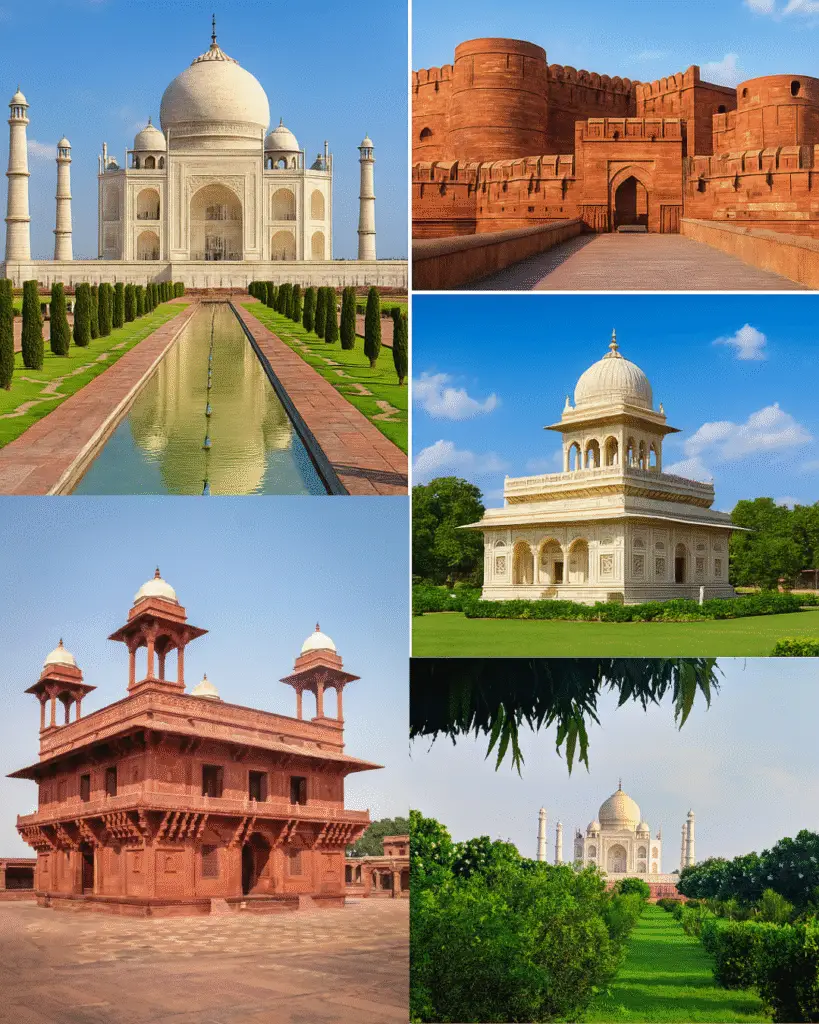
Best Places to Visit in Agra – Unveiling the Timeless Charm of the City of Love
Best Places to Visit in Agra — the city that houses the world-famous Taj Mahal — is more than just a symbol of love. Located on the banks of the Yamuna River in Uttar Pradesh, this ancient city served as the seat of the Mughal Empire for generations. Today, Agra stands as a blend of royal history, architectural brilliance, and vibrant local culture.
Whether you’re a history lover, a photographer, or a traveler in search of inspiration, Agra has something for everyone. From the awe-inspiring monuments to serene gardens and bustling markets, every corner of this city tells a story. Agra taxi provide best sighseeing tours in agra.
Taj Mahal – The Eternal Symbol of Love
No list of the best places to visit in Agra can begin without the magnificent Taj Mahal. Built by Emperor Shah Jahan in memory of his beloved wife Mumtaz Mahal, the Taj Mahal is an enduring symbol of eternal love.
Crafted from pure white marble and adorned with intricate carvings, the Taj is a masterpiece of Mughal architecture. The play of light at sunrise and sunset adds a magical aura to the monument.
Highlights:
- Built in the 17th century
- UNESCO World Heritage Site
- Located on the Yamuna River bank
- Popular for sunrise and full-moon visits
Travel Tip: Arrive early in the morning to witness the Taj Mahal bathed in golden sunlight — a truly unforgettable experience.
Agra Fort – A UNESCO World Heritage Gem
Another architectural wonder, Agra Fort, is a symbol of the Mughal Empire’s power and grandeur. Commissioned by Emperor Akbar in 1565, this massive red sandstone fort once served as the royal residence and military stronghold.
Inside, visitors can explore magnificent palaces, mosques, and courtyards — including the Jahangiri Mahal, Diwan-i-Khas, and Moti Masjid. From its ramparts, you can even catch a distant view of the Taj Mahal.
Highlights:
- Blend of Hindu and Mughal architectural styles
- Houses several palaces and audience halls
- Part of the Golden Triangle (Delhi–Agra–Jaipur) circuit
Did You Know? Shah Jahan spent his last years imprisoned in Agra Fort, gazing at the Taj Mahal — the tomb of his beloved queen.
Mehtab Bagh – The Moonlight Garden
Situated directly opposite the Taj Mahal, Mehtab Bagh is a beautifully designed garden offering stunning symmetrical views of the monument. This charbagh-style garden (fourfold layout) was built by Emperor Babur and later restored by Shah Jahan.
It’s the perfect spot for photographers and romantic couples, especially during sunset when the Taj glows golden against the river backdrop.
Highlights:
- Ideal for photography and relaxation
- Provides the best rear view of the Taj Mahal
- Entry fee is minimal and the crowds are lighter
Fatehpur Sikri – The Abandoned Mughal City
Located about 40 km from Agra, Fatehpur Sikri is a UNESCO World Heritage Site and one of the finest examples of Mughal architecture. Built by Akbar in the late 16th century, this once-thriving capital city was mysteriously abandoned due to water scarcity.
Visitors can explore the Buland Darwaza, Panch Mahal, and the Tomb of Salim Chishti, each reflecting incredible artistry.
Highlights:
- Combination of Persian and Indian styles
- Houses the world’s tallest gateway – Buland Darwaza
- A perfect day-trip destination from Agra
Radhasoami Samadh – A Sacred Symbol of Faith and Tranquility
Located in Soamibagh, agra, just a few kilometers north of Agra city center, the Radhasoami Samadh (also called the Soami Bagh Samadh) is one of the most serene and spiritually uplifting places to visit in Agra. It serves as the memorial of the founder of the Radhasoami Faith, Param Purush Puran Dhani Soamiji Maharaj (Shiv Dayal Singh Ji).
Architectural Grandeur
Construction of the Radhasoami Samadh began in 1908 and continues to this day, making it one of the longest-running architectural projects in India. The monument is built primarily in white marble, much like the Taj Mahal, and features intricate carvings, detailed floral patterns, and delicate inlay work.
The design beautifully combines Hindu, Islamic, and Christian architectural elements, symbolizing the unity of all faiths — a core belief of the Radhasoami philosophy. The structure’s central dome, pillars, and inner sanctum reflect remarkable craftsmanship that showcases devotion and artistry at its finest.
Spiritual Significance
The Radhasoami Samadh is not just an architectural masterpiece but also a center of deep spiritual devotion. Followers of the Radhasoami Faith believe in the teachings of love, truth, and inner realization. The site serves as a hub for meditation, prayer, and community service.
Every day, devotees and visitors gather here to offer prayers and experience the calm, divine atmosphere of the premises. The surrounding area, known as Dayalbagh, is a self-sustained community that promotes education, self-reliance, and spirituality.
Visitor Information
- Location: Soamibagh, Agra, Uttar Pradesh
- Entry Fee: Free
- Timings: Open from 10am to 5pm
- Photography: Generally not allowed inside the premises
- Best Time to Visit: Morning or evening hours when the sunlight enhances the marble glow
Travel Tips
- Dress modestly as it is a religious site.
- Maintain silence inside the complex to respect the sanctity.
- Combine your visit with nearby attractions like Akbar’s Tomb (Sikandra) or Mariam’s Tomb for a complete historical-spiritual experience.
- You can easily reach Soamibagh by auto-rickshaw or taxi from central Agra.
Itmad-ud-Daulah’s Tomb – The Baby Taj
Often referred to as the “Baby Taj Mahal”, this exquisite monument is said to be the first Mughal structure built entirely of marble. It was commissioned by Noor Jahan for her father, Mirza Ghiyas Beg.
The intricate pietra dura inlay work and delicate lattice screens make it a true architectural gem.
Highlights:
- Precursor to the Taj Mahal’s design
- Peaceful, uncrowded environment
- Elegant Mughal gardens
Akbar’s Tomb at Sikandra – A Grand Resting Place
Located in Sikandra, the Tomb of Akbar the Great is another must-visit site. This sprawling complex features a perfect blend of Islamic, Hindu, and Persian designs, reflecting the emperor’s secular ideology.
The lush gardens and peaceful surroundings make it a great escape from city noise.
Highlights:
- Built by Akbar’s son, Jahangir
- Enclosed by red sandstone walls
- Houses ornamental gates and peacocks roaming freely
Jama Masjid – An Architectural Marvel
Built in 1648 by Shah Jahan’s daughter, Jahanara Begum, Jama Masjid is one of the largest mosques in India. The mosque’s grand courtyard, intricate marble carvings, and red sandstone domes stand as a testimony to Mughal craftsmanship.
Highlights:
- Located near Agra Fort
- Still functions as a mosque
- Vibrant local bazaar nearby
Chini Ka Rauza – The Persian Masterpiece
Dedicated to the Persian poet and scholar Allama Afzal Khan Mullah, Chini Ka Rauza is known for its glazed tile decorations — a unique art form brought from Persia.
Though less visited, it’s one of the most colorful Mughal monuments, reflecting Persian influence in Agra’s architecture.
Guru Ka Tal – A Sacred Sikh Pilgrimage
Guru Ka Tal is a revered Sikh pilgrimage site built in honor of Guru Tegh Bahadur Ji. With stunning architecture and a peaceful atmosphere, it’s a spiritual destination worth exploring.
Highlights:
- Built in the 17th century
- Features Mughal-style domes and arches
- Attracts thousands of devotees yearly
Best Time to Visit Agra
The best time to visit Agra is between October and March, when the weather is cool and pleasant. Avoid peak summer months (April–June) due to high temperatures.
How to Reach Agra
- By Air: Nearest airport – Pandit Deen Dayal Upadhyay Airport, Agra.
- By Train: Agra Cantt Railway Station connects major Indian cities.
- By Road: Excellent connectivity via Yamuna Expressway and NH-19 from Delhi and Jaipur.
Tips for Exploring Agra Like a Local
- Start early to avoid crowds at the Taj Mahal.
- Try Agra’s famous Petha (sweet) and Bedai-poori breakfast.
- Hire local guides for detailed historical insights.
- Explore Sadar Bazaar for souvenirs.
- Book reliable taxi services for comfort and convenience – such as Agra Taxi
.
FAQs about the Best Places to Visit in Agra
Q1. What is the most famous tourist attraction in Agra?
The Taj Mahal is the most iconic and visited site in Agra.
Q2. How many days are enough to explore Agra?
Two full days are ideal to cover all major attractions.
Q3. Is Agra safe for solo travelers?
Yes, Agra is generally safe. Stick to tourist areas and book verified transport.
Q4. Can I visit Taj Mahal at night?
Yes, the Taj Mahal is open for night viewing on full moon nights (limited tickets available).
Q5. Which local foods should I try in Agra?
Don’t miss Agra Petha, Bedai-Poori, and Mughlai cuisine.
Q6. What are the best shopping spots in Agra?
Sadar Bazaar, Kinari Bazaar, and Shah Market are popular for handicrafts and leather goods.
Conclusion – Rediscover Agra’s Timeless Magic
Agra’s timeless beauty lies not only in its monuments but in the emotions and artistry they embody. From the romantic allure of the Taj Mahal to the grandeur of Agra Fort and the serenity of Mehtab Bagh, each destination reflects a piece of India’s royal past.
Find taxi service near me in agra whether you’re a first-time visitor or a returning traveler, Agra never ceases to inspire awe. Plan your trip today, and let this historic city weave its magic around you.
